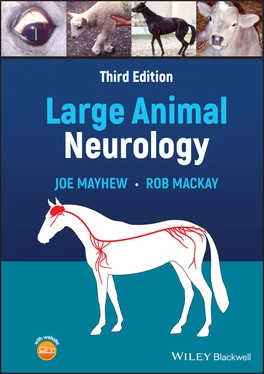Evidence of prior self‐inflicted trauma over bony prominences or on the tongue or gums as seen here can herald the onset of epilepsy as seen by an upper lip lesion in this foal.
Large animals, especially horses, often become violent in response to painful processes and when attempting to regain their footing. These intermittent and sometimes continuous episodes of struggling and thrashing are difficult to distinguish from convulsions. Secondary head trauma often ensues, usually adding to the delirious state. Primary processes that fall in this category include colic, myopathy, vertebral injury, long bone fractures, and acute spinal cord, brainstem, and particularly vestibular disease.
Because suspected epilepsy does appear to be more frequently a presenting problem in horses, and some attempts have been made to classify these, 13,14a few specific comments are warranted for that species. Repeated generalized seizures that persist, with no active underlying disease process identified, and occurring in families of purebred animals, are true or idiopathic epilepsy. This does not appear to have been demonstrated in adult horses, although it may have been seen in some breeds of cattle. 15However, a patient that has had one seizure from any cause is more likely to have another—a process referred to as kindling. Thus, epilepsy beginning in adulthood in horses can be regarded as acquired until proven otherwise. Any morbid or biochemical forebrain lesion potentially can act as a seizure focus, and the resulting epileptic syndrome may begin days to years after the initial lesion. Also, a nonprogressive cerebral lesion such as an old glial scar may result in epilepsy that resolves, progresses, or remains stable.
Repeated seizures in neonatal foals most frequently indicate sepsis or neonatal encephalopathy, 16–18and a similar syndrome has been seen in calves suffering birth asphyxia with resuscitation ( Figure 6.1). Equine familial isolated hypocalcemia (EFIH) in Thoroughbred foals, hypoglycemia, and possibly hyperbilirubinemic encephalopathy (kernicterus) should also be considered in young patients, 19,20and in adults under appropriate situations. 21Adolescent foals, especially of the Arabian breed, can suffer from epilepsy that is of genetic origin 22,23and can also suffer from severe seizures associated with the lethal Lavender foal syndrome. 22,24In the genetic adolescent epilepsy, seizures are usually symmetrical and generalized, and the first seizure may accompany an episode of sepsis or other acquired diseases. Control of the seizures with medication is usually successful, and the patients appear to grow out of the condition. Finally, although not true epilepsy, foals and calves with severe cerebellar disease have been seen to have convulsive episodes regarded as cerebellar fits, but they are aware of their environment during these attacks.
On a practical note, the recommendation to proceed with straightforward epilepsy cases having no interictal signs to advanced diagnostic imaging is not really helpful unless everything possible, including heroic intracranial surgery, is to be entertained. The utility of electroencephalography and MR imaging in improving the outcome of such cases has been discussed, 25,26but is not widely accepted.
Signs that may relate to a focal forebrain lesion that is a potential seizure focus must be searched for during an interictal—not postictal—neurologic examination. Such signs include asymmetric menace responses, asymmetric nasal sensation, anisocoria, a head deviation with or without blindfold applied, facial paresis and facial hypertonia, and asymmetry in hopping on the forelimbs. If an epileptic horse is essentially healthy with minimal or no neurologic signs evident between seizures, then most possible causes of forebrain disease that include viral encephalitis, hepatoencephalopathy, leukoencephalomalacia ( Fusarium sp. mycotoxicosis), and other toxicities are exceedingly unlikely to be the cause of the epilepsy. Three diseases at least should however be given consideration as underlying specific causes in such situations. In horses that have been on the American continents, equine protozoal myeloencephalitis caused by Sarcocystis neurona or Neospora hughesi must be considered. 27Serum and cerebrospinal fluid immunoassay tests can be performed so that appropriate treatment can be initiated and continued if the tests are positive. In most countries, consideration should be given to treatment for thromboembolic and migratory verminous encephalitis at the beginning of an epileptic syndrome using larvicidal doses of anthelmintics and short‐term nonsteroidal anti‐inflammatory or glucocorticosteroid therapy. And third, cases with bacterial granulomatous ependymitis and choroiditis, true brain abscesses, and cholinisteric granuloma can be insidious in their clinical progression, and one or more seizures may be the initial overt sign. Indeed, in an aged horse with epilepsy that may be responsive to glucocorticosteroid drugs for quite some time, cholinisteric granuloma must be given strong consideration. 28Various surgical and antibacterial therapeutic regimens are feasible, but heroic approaches in such cases. Rare occurrences of ear tick infestation, hypoglycemia associated with pancreatic neoplasia, intracranial neoplasia, and vascular dysplasia might be considered. 29–31
Guidelines aimed at assisting in the handling of large animal epileptic patients and in advising owners are not available, thus recommendations are rather empiric. To begin with, it must at least be reported to the owner that a patient with epilepsy is unsafe to ride until seizure free and not on anticonvulsant medication for at least 6 months. Also, if the horse injures itself to require veterinary attention, and thus documentation of the injury for the record, then euthanasia must be considered ( Figure 6.1). With respect to this decision, and in reporting to an insurance company, it is reassuring to have a video of one of the seizures and to have some, albeit subtle, interictal sign to corroborate the horse having epilepsy associated with an acquired intracranial morbid disease process. On the other hand, a sensible owner can be advised that the vast majority of seizures will occur at quiet times and not while working; however, the written report must state that the horse is unsafe to ride.
The following points are a guide to maintenance anticonvulsant therapy to help control seizures in epileptic adult horses:
Have the owner keep a diary of seizure activity and all medication given.
All anticonvulsant drugs are not licensed for use in large animals.
Begin phenobarbital at 5 mg/kg BID, PO.
Increase the dose about 20% every 2 weeks until persistent sleepiness occurs or seizures are not controlled.
Reduce dose say by 20% and add KBr at 25–90 mg/kg SID, PO, with or without loading doses of 120–200 mg/kg SID, PO for 1–5 days. 41
Consideration then can be given to incorporating phenytoin, carbamazepine, gabapentin or levetiracetam, etc., to the regimen if further control required and/or side effects are unacceptable.
After control, monitor serum concentrations and aim to keep them in the therapeutic ranges (e.g., phenobarbital, 15–40 μg/mL; bromide, 1000–4000 μg/mL).
Seizure threshold may be lowered with estrogen, therefore anticonvulsant dosage may be increased prior to onset of and during estrus activity.
If the patient is completely seizure free for 6 months. then slowly wean the patient off one drug at a time over 3 months. If seizures begin, raise the dose again.
Interactions must be considered when other drugs are to be administered to an animal already on anticonvulsant therapy.
These guidelines may be extrapolated to other species. Metabolic disorders especially hypocalcemia and hypomagnesemia must be considered in ruminants. All ruminants that have seizures of uncertain cause should receive gram doses of thiamin immediately after any diagnostic samples have been drawn for red cell transketolase activity.
Читать дальше












